Economic arguments for art practically break my heart
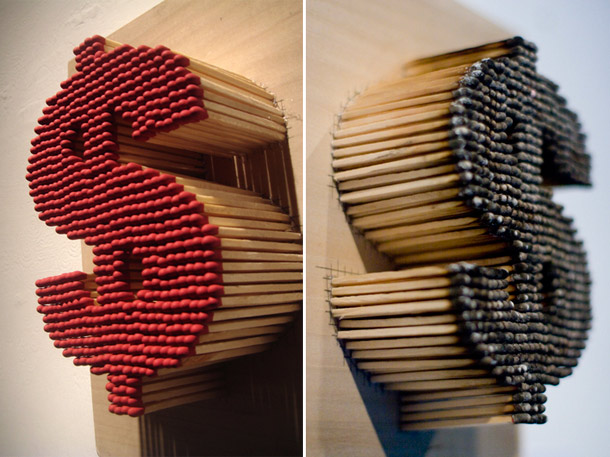
From ‘Playing With Fire‘ by Pie-San Ng

From ‘Playing With Fire‘ by Pie-San Ng
When I first took over editing the Praxis Theatre website in 2008, the thearosphere as I knew it was bustling and largely made up of North American bloggers and also The Guardian website. Blog posts would routinely have thirty or more comments, and the creators were familiar with one another and the arguments and ideas they were presenting.
Fast-forward seven years and the theatrosphere is something else entirely. This legacy can be understood in how so many sites, including this one, use WordPress as their content management system. Websites are now so much more than an online printing press for text with some static images this evolution began with. The Web 2.0 revolution has brought a fragmented, algorithmic, heavily interactive mode of expression that includes many more voices, but each in a silo determined by privacy settings and circle of humans one publishes to. This edition attempts to capture these ‘micro-blogs’ that have become the new medium, in an older iteration of the same medium.
What have we lost and what have we gained through this process?
Here's how #MondayNights ended for us. @6thmancollective
A video posted by Michael Wheeler (@michaelcwheeler) on
These are some of the more compelling Facebook posts I saw this week that were published with “Public” privacy settings, allowing me to embed them. This is a thing Facebook lets you do now.
Toronto actor Tony Nappo is making a movie with Ethan frigging Hawke. Tell him Boyhood set a new standard for cinema for me.
Darren O’Donnell set of a massive conversation about the value of a life in the arts with this post.
We made this announcement at my other job last week.
This week i tweeted that we have hit “peak incubation”. Theatre Centre should ignore this. Clearly this strategy is working for them.
Fun Palace Radio is a thing. Check it out live or online. We like projects that provide that option.
As this is after the after party, I can only assume this was taken in the hotel lobby.
I have been critical of The Coalition in the past for being too cozy with a government that is pretty antithetical to the values most artists hold, so I was pretty enthused by this post.
You can see more of Laurel’s work expressing the creative process to Charlotte’s Web via Instagram in her article in this Edition.
Oh hey Jordan Tannahill is taking over, I should probably harass him more about that Wrecking Ball play we started working on.
SummerWorks is accepting applications and doing this differently this year.
I put this in here because I was reading This Changes Everything last night and basically it’s now or never people. No one will remember the Dora noms, everyone will remember the apocalypse.
Podcast: Play in new window | Download
Subscribe: Apple Podcasts | RSS
Jacob and Vicki talk about Vicki’s recent family vacation to theme parks in California, where she became an honorary citizen of Disneyland.
The line up is not the ride, but it is part of the ride.
What is the audience experience of ‘being there’ at the theatre? Let’s talk about entertaining.
Vicki Stroich @vickistroich
Jacob Zimmer @jacobzimmer
Theme song of episode: The Staff by Multifaros
Things we talk about:
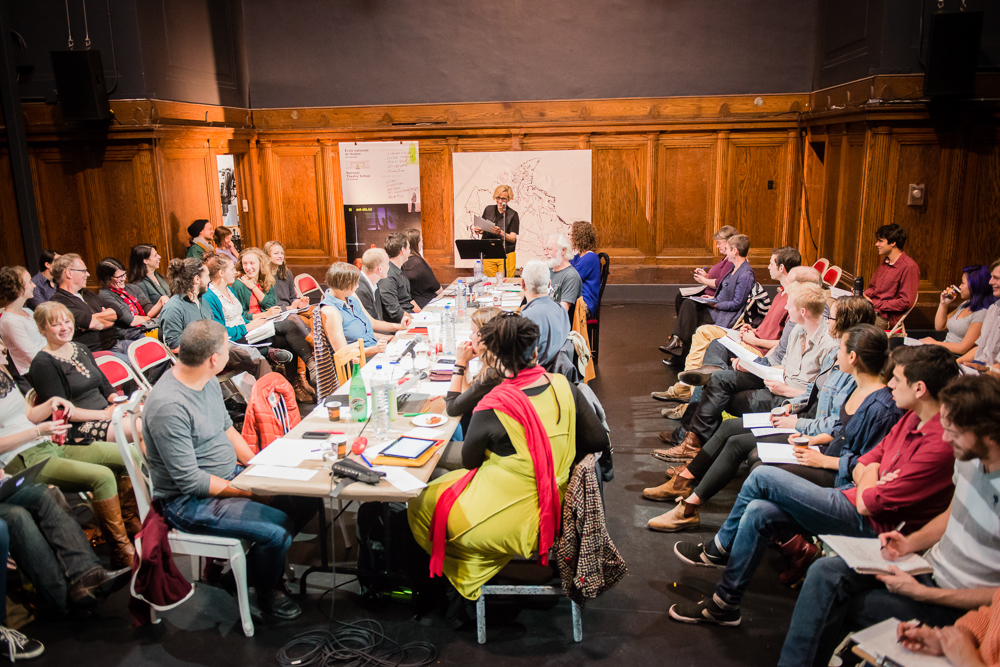
The following is an excerpt from the last half of my Keynote Address, delivered at NTS as part of the “From Where I Stand” symposium held in Montreal on October 3rd and 4th, 2014.
I believe that we are living in a time of Citizen Story Theatre. I think it’s a good idea to take a citizen’s stance when contending with the problems of living in this country today and choosing to make theatre about it.
In my mind Citizen Story Theatre is an action that began for us: “us” meaning all of us here in this room, with our shared culture of apology.
There is this thing called a social or national imaginary that is held in tact by the establishment. In our imaginary, the one the media and Google guides us towards, we are told that we are not living in a culture that is knowingly transgressing in the present, instead our collective imaginary tells us that we are living in a culture where past transgressions are constantly and rightfully being apologized for, and as well, a culture where the older generation, my generation for sure, spend a lot of time talking about the end of days.
In my humble opinion this notion, this imaginary, is breaking down or is already broken but…
But for now, it goes something like this: “Nothing is happening now, a lot of bad stuff was happening then, and it looks like a lot of bad stuff is for going to happen in the future.”
And for this: the older, established, generation are just so very sorry.
Depressing sounding stuff. This does not, by the way, reflect the perspective of a lot of the younger artists that I meet. I mean just take a look at Mitchell Cushman and Simon Bloom at Outside The March (Toronto/Edmonton), or Mel Hague at Rhubarb Festival and Obsidian (Toronto) or Ryan Cunningham now at Native Earth (Formerly of Alberta Aboriginal Arts) or Daniel Thau-Eleff at Moving Target Theatre (Winnipeg ) or Cole Alvis ED of IPAA and co-conspirator with Mel at Rhubarb and Lemon Tree Creations (Toronto).
Or what about Jajube Mandiela and Alison Wong, at bcurrent in Toronto and Ravi Jain and Why Not Theatre in Toronto and everywhere else… or Chris Gatchalian at the Frank Theatre (formerly known as Screaming Weanie Productions) in Vancouver…
Hell, while in Vancouver you can see what Christine Quintana at Neworld (among others) is cooking up or the audacious dramaturg Fannina Waubert de P (Who for a time was in residence at The Arts Club just by spending a few seconds on Twitter) And why stop there when you can head to Yellowknife to catch up with Renaltta Arluk and her Akpik Theatre. And this does not even begin to take into account Jordan Tanahill and Erin Brubacher and others at Videofag and Suburban Beast in Toronto or Stewart Legere and his various collaborators in Halifax. Oh yeah, and at NAC Corey Payette is our artist in residence and he was recently named artistic director of Urban Ink in Vancouver! And while older than a lot of you, you have some serious youth at the helm of the school in Gideon. And total young at heart-ness everywhere else. So it is important to note that most young people are not locked into the state of sorry.
And while the sounds of dour forecasting sit well with Debajemujig Storytellers on Manitoulin Island, they are after all the second oldest professional Indigenous Theatre Company in Canada (founded in 1984)… so they have their aged card… it does not represent the buzz of positivity, activity and performance behaviours enacted by this company. They are touring the world (but only when invited and based on a developing and developed relationship with other companies who share their vision). They spent this past summer, for example, offering their show The Global Savages to audiences at Citizens Theatre, in Glasgow. Their show holds stories that are connected to the 6th teaching in Debaj’s teaching bundle: 6th teaching is to preserve the human race. In fact all the choices this company now makes… are in pursuit of this 6th goal… and are held in place by the 5 other values. This weekend they are doing the Six-Foot festival – this event puts the performance of permaculture and intentional living at the heart of the Festival. Later this year they will hold The Festival of 1000 skills where essential life skills will be performed so that audience members can retain them for their future survival.
Difficult times …exciting response… artists acting citizens on fire.
This past summer I was sitting in on rehearsals for Watershed . This is s new work by Annabel Soutar of Porte Parole, directed by Chris Abraham of Crow’s. I get to do this because I curate The Collaborations at NAC. This is an artistically led initiative to invest in work germinating on its own soil. Local builds a great national conversation – I say.
Anyway… Watershed is an extraordinary examination of what is happening to us as a nation; as seen through the lens of our diminishing access to fresh water. During a pause in rehearsals, I asked the actors how they were dealing with the anxiety of this examination and how, for the parents in the cast, – in particular – how they were negotiating the known impacts of their research on future generations and…. big name drop coming in… Eric Peterson said: “The thing is, kids don’t see the loss, they only see the existence of what is.”
Older people talk about what was. Children talk about what is. And young adults make the future. That’s where you all come in.
Citizen Creators uniting for the future.
Getting old is extremely weird. I am 51 now, and when I look out across this country all I see is change. Not only has the actual National structure of 10 provinces plus 2 territories become a cool 10 + 3… but, as well, many of our varied historically hostile practices have come under review.
So I am not Jewish or Muslim but tonight is Yom Kippur and this is the night where atonement ends, and where, according to Jewish practice, we should ask to be forgiven by our fellow humans and we should also forgive. It is also the beginning of Eid al-Adhaan an Islamic holiday to remember and commemorate the trials and triumphs of the Prophet Abraham.
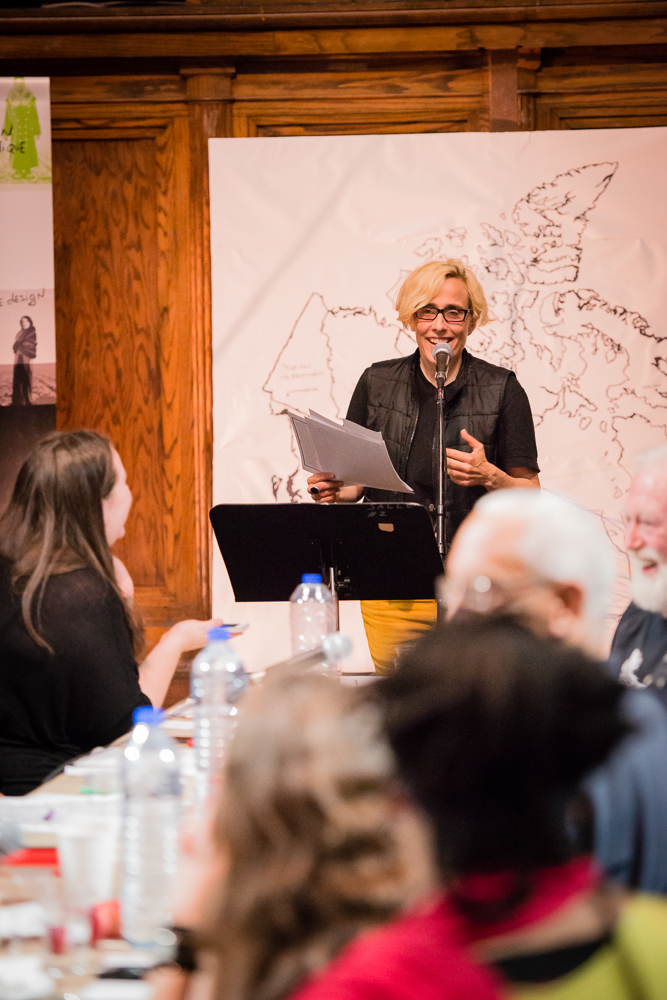 For the past year The Truth and Reconciliation Commission has been active in Canada. This work is being done to acknowledge and uncover the systematic and heart-ravaging costs of separating young Indigenous kids (First Nations, Métis and Inuit) from their parents and their culture. These kids were shipped off to residential school and the damage reverberates in every corner of this land. The last residential school to close was in 1996.
For the past year The Truth and Reconciliation Commission has been active in Canada. This work is being done to acknowledge and uncover the systematic and heart-ravaging costs of separating young Indigenous kids (First Nations, Métis and Inuit) from their parents and their culture. These kids were shipped off to residential school and the damage reverberates in every corner of this land. The last residential school to close was in 1996.
Now this might seem like deep history to some of you, after all, some of you were born that year, but I still cannot believe that this was happening while I was walking the streets of Toronto, dying my hair blue … or dying it exactly the same colour it is today… how embarrassing … I cannot believe this was happening while I was making a name for myself, making big works, becoming an associate artist at Buddies in Bad Times Theatre, hitting a bunch of cool career targets. I can’t believe it. This knowledge of my ignorance has deeply affected me… and caused me to re-calibrate how I look at the world. From where I stand we have a lot of explaining to do and we have very, very different stories that we, as a country, need to hear, re-hear and tell and re-tell.
Some apologies and some stories.
6 years ago, on June 11, 2008, Prime Minister Harper stood up in the House of Commons and said: “… on behalf of the Government of Canada and all Canadians, I stand before you, in this Chamber so central to our life as a country, to apologize to Aboriginal peoples for Canada’s role in the Indian Residential Schools system.”
There are Canadian plays written about this. Corey Payette is working on one right now called Children of God – it is having a reading at The Arts Club as part of their RE-ACT series on November 8th
That same year… a few months later in BC…Harper apologized for the 1914 Komagata Maru incident in which hundreds of South Asians seeking a better life in Canada were turned away.
There are Canadian plays written about this. Sharon Pollock who wrote Doc, and Blood Relations also wrote a play called The Komagata Maru Incident way back in 1976 … but I believe that Ravi Jain (of Why Not Theatre and A Brimful of Asha fame) and Andrew Shaver (who just directed The Graduate at The Segal Centre and is AD of Sidemart Theatrical Grocery) are working together on a piece about this right now called Give Me Shelter.
8 years ago in June 2006, Prime Minister Stephen Harper: “offered a full apology to Chinese Canadians for the Head Tax and expressed his deepest sorrow for the subsequent exclusion of Chinese immigrants from 1923 until 1947”
There are Canadian plays written about this like (AD of FU-GEN Theatre in Toronto) David Yee’s Governor General Award nominated Lady in the Red Dress
18 years before that, Prime Minister Mulroney apologized to Japanese Canadian for their internment during WW2. Roughly 22 thousand Japanese-Canadians were re-settled during this period in response to a national(ist) fear about their disloyalty to Canada. They lost all their property and businesses and were sent to BC from all corners of Canada.
There are plays written about this too. Mitch Miyagawa formerly of Whitehorse – for example – wrote the widely acclaimed The Plum Tree.
For every apology I bet you could find a play. That is what artists do. They respond. We feel as citizens and we respond as artists. We are citizens telling our stories in the theatre.
I am not sure if anyone has written a play for the 2004 Superbowl halftime nipplegate – and its famous apology – involving Justin Timberlake and Janet Jackson’s nipple… but maybe it is just still too soon or maybe just too American. Or maybe the big news stories are simply there to distract us from the reality of our lives. And this, again, is where we, as artists and as citizens, do our daily work, on the ground, where it matters.
If I start with the 1988 apology, I see that my government saying it is sorry has shaped the bulk of my adulthood. The plays that were made throughout these years were often issue-driven and identity based. Some might contend that this led to a weakening of our dramaturgy. I think the opposite is true. I think it was the portal through which we began to see ourselves as a nation. I think we were on a path towards uncovering truths about what it means to live collectively, indeed collaboratively with one another on this land.
But now, if I drill down even further I find that something curious is happening… the apologies appear to be slowing. The language appears to be shifting.
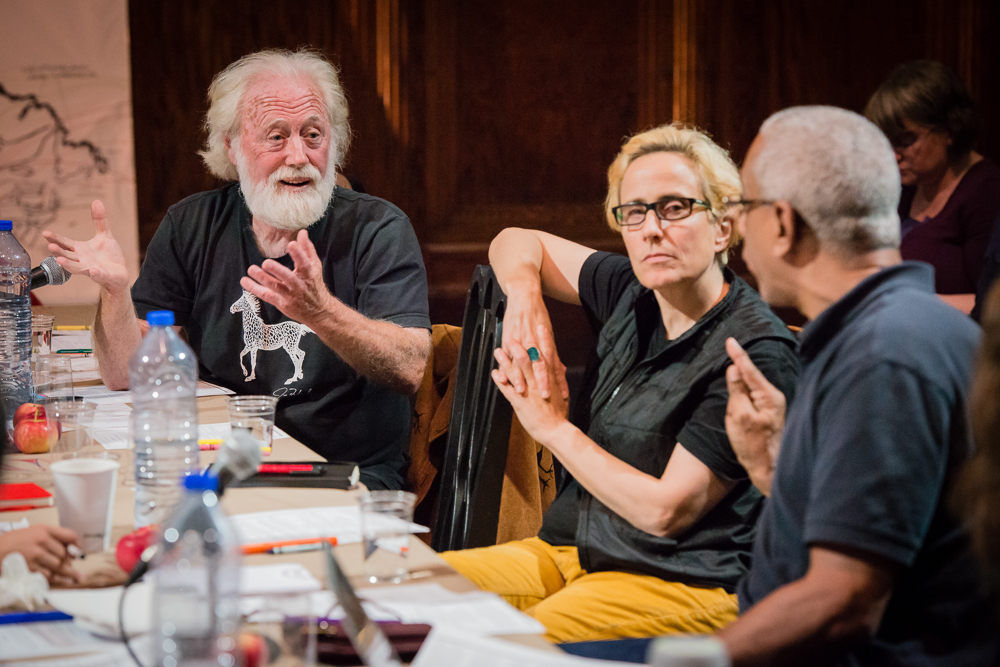
In your recent past we have been witness to the 2010 G20 horror show in Toronto. During this time basic civic rights were completely ignored. Tommy Taylor wrote a play about that called You should Have Stayed Home. We have, as well, faced the disappearance of literally countless Aboriginal women and are faced with Federal government who refuses to acknowledge this, or seriously look at what needs to change. Marie Clements wrote The Unnatural and Accidental Women and Keith Barker’s The Hours That Remain. We have a government that is systematically stripping away our rights and privileges… Don’t even get me started on immigration, but as salve and action both, I recently saw Body 13 by MTspace and through The Collaborations, we invested in Mary Vingoe’s Refuge. These 2 plays – are among many – all created by citizens grappling with the ever-deepening immigration crisis.
Here is something that I believe about theatre in good and bad times: It is best envisioned by the young and is best enjoyed by the old.
Theatre gives older people the opportunity to live again. It gives older people the chance to revisit past loves, past mistakes, past victories and to revel anew. It also gives older generations an opportunity to see how they might redress an imbalance. Young people are closer to the ground. Your vision can lead us out of the murk. This is the gift and grace of the theatre.
But in more turbulent times, when the apologies stop and the transgressions begin anew, then the theatre becomes a place for change now. Its poetic impact – of necessity – alters, and therefore its form must too.
Traditionally, theatre about the young for the young remains marginalized, and undervalued. (Jordan Tanahill’s Concord Floral is making a mockery of this notion) Traditionally, older generations have been needed to help pay for work, to critically praise the work, and if the older generations cannot gain entry, then the work dies under-resourced on the vine. But in moments of great need, such as now, traditions change. The theatre reconstructs itself. Today it becomes a civilizing square where true citizen engagement and discourse can occur. Troubling times breed Citizen Story Theatre.
You are here. Hopefully it is – in part – because you want to help the world. Or maybe you just want to make people laugh or cry. And this, my friends, is every bit as good. Laughter and tears on the square are as valuable as action.
IMHO we have to stop asking: “why theatre is important?” and instead accept the mission of our gift. Through our shared heritage we as Canadians have been bequeathed the desire to bring performer and spectator together; paratheatre; a form that Indigenous peoples had been practicing long before the first “play’ was ever imported to these shores. A form that I will flippantly conjecture was loaned to Grotowski from the ancients. Nothing wrong with that. We have much to learn from what went before us. By listening to the stories of this land we get to make the world a little less crazy and a lot more forgiving. And if we are very lucky we get to participate in a really great show.
I cannot thank you enough for lending me your ears.
Citizen Stanley over and out.
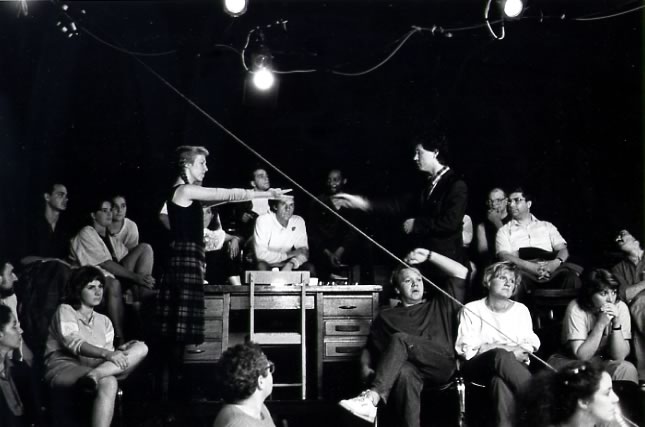
Nothing, with the exception of recounting last night’s dreams, is more boring than nostalgia. Nothing distorts history like nostalgia. And nothing hobbles an argument like an appeal to nostalgia. Nonetheless.
I’ll restrict myself to the scene I came up in: Toronto theatre in the late 1980’s and early 90’s. Hillar Liitoja and Sky Gilbert were the avant-garde, Theatre Columbus and Smith Gilmour and Crow’s and Necessary Angel comprised the seat of small theatre, Passe Muraille and Factory and Tarragon were the bigger small theatre, Marlene Smith and Mirvish and Drabinsky operated outside public funding.
That’s a reductive list, I can hear you shouting, but for the purpose of the argument I want to make, it’ll do. It describes a reasonably healthy ecology, created by a few decades of steady arts funding, the audience numbers ascending (sometimes spasmodically, but in the main, ascending). Were there rivalries? Sure. Resentments? Of course. Writers and actors and audience sometimes felt excluded by the gatekeepers at each institution.
This spurred discussion, or, sometimes, the shaky creation of new, barely tenable institutions. There was never enough money. Passe Muraille always seemed to be a day or two from evaporation. So did Factory. So did we all: only a few could make a living doing the single thing they wanted to do. The rest of us hyphenated our professional identities and became actor-writers, actor-directors, writer-chef-caterwaiters.
There was never enough money. Equity fought to get actors more of it, while trying to support the delicate ecology. New plays were created by places that really couldn’t afford their new play development programs. Buildings mouldered. There was never enough money.
This was the eighties, which gave way to the nineties, which spawned Mike Harris and Reform. Reagan and Thatcher made it here, finally. Our smugness evaporated. And in the arts, the money dried up.
It started with a public discussion about who should fund art. About what a government’s role in the development of an art form should be. It was part of a larger conversation about shared values, about what society is for, about other voices taking space from the voices that had been dominant for so long. It was the Common Sense Revolution, it was Reform, it was “what, if anything, did we miss out on by Reagan and Thatcher taking so long to arrive?”
And the money, already inadequate, dried up. We fought. In the Toronto theatre we fought for art’s usefulness, and the fight went to Ottawa and across the country. And we lost the fight. It seems harsh to say we lost, especially since there are those who continue to make the arguments, especially since the OAC and the Canada Council and the TAC still exist, but what we lost was this:
Culture, it was decided, is not central to this society. It’s of use, it connotes a degree of civilization, but it’s not central. Culture is great, but it’s not worthy of a place in our collective life like, say, the economy is. The economy, so easy to measure and parse and fight over and politicize, dominates our discussions about society, about what we mean to each other.
So the money dried up, and eventually most of us stopped making the arguments about culture’s centrality to a society. Those arguments became sort of embarrassing. So we stopped fighting for our art and what happened was: we started to fight with each other.
The earliest fights of this new era were over the economics of art: could we as artists, use the tools of the dominant discourse to make ourselves somehow valid again? Would casting art’s value to a city in monetary terms lend us credibility? Arts organizations began making economic arguments to funders. Funders began to expect these justifications from artists. And some artists hated this line of argument, made no secret of hating it, and divisions emerged between those who believed in making that pitch and those who felt it cheapened the art.
Businesspeople were invited to join arts boards, fundraising in the private sector became a large part of a theatre’s job, and some people hated this and some people were grimly pragmatic about it. When the Stratford Festival announced proudly that less than 5% of its revenue came from public sources, some thought that was enviable, and some thought it a travesty. Stratford became either an innovative institution or a sellout shitshow, and which side of that you came down on said a lot about you.
We started to fight with each other because the original fight was lost. Suddenly Equity, always sort of hapless, became a locus of our discontent. How dare they stand between me and my art? If I choose to forego a meaningful price for my art, who are they to intervene?
And how is it that a segment of the form that interests me not at all, that I consider empty, how is it that Luminato (for example) has access to public money I can’t even begin to dream of?
And why won’t that older generation of artists finally release their grip on these mouldy institutions? How can we be expected to grow my art when nobody my age is a gatekeeper? How can we wrest power from the gerontocracy?
And how come airquotes established artists abuse the very notion of The Fringe by taking up slots that should go to airquotes legitimate fringe artists?
And when will midsized theatres, providing a constant, thin gruel of empty entertainments, take responsibility for destroying audiences?
And why do millennial artists insist on maligning what exists in the Toronto theatre, instead of building it?
And how could a man’s legacy possibly mean as much as the survival of the theatre he created? Created and saved?
And why can’t critics recognize they don’t mediate our experience in the way they once did? Conversely, why would a theatre presume to exclude critical appraisal, so useful for box office and as a catalyst for feedback, from the birth of a play?
Why is everyone so hostile? There was a time when we hated each other, laughed at each other up our sleeves, swiveled our heads in bars before eagerly bitching about each other’s work, resented the fuck out of each other’s successes. But, and here comes the nostalgia, we were all in it together.
We lost the fight, and now we fight each other.
I’m willing to take my share of the responsibility for losing that fight. The revolution that theatre makers of the 60’s and 70’s made seem so real and available shuddered and stopped around the time I was hitting my stride. Why didn’t I do more to leverage the Drawer Boy’s success toward insisting on art’s centrality in our society? That play was an argument for the tangible usefulness of art, but I didn’t spend much time at all amplifying its themes beyond the theatre; I happily preached to the already converted.
The best argument was a good play, we told ourselves. The fight was over, and we lost, and it’s now embarrassing to compare ourselves to places where art is central, so let’s get on with what’s possible here. Let’s do what we can, compete with our peers for what’s left of the public money, and call out those peers when the competition is imbalanced in any way.
So look. We can either have the dozens of fights among ourselves that will insure our insularity. And we will survive, and change in small ways, and some ideas will become paramount and some will fall away and we will in no way move beyond the bounds within which we currently exist.
Or we can decide to have the fight all over again. Decide to insist that art take its place at the centre. My ears are actually getting hot with embarrassment as I type that.
Decide that Paul Thompson’s and Ken Gass’s revolution was just on pause, and stop fighting with each other over knucklehead stuff, and together make this place electric.

Are you a Cathedral Thinker?
Almost my entire career has been in some way in service to the arts and community.
Some of the most remarkable moments of my career have been those beautiful and intimate times when the arts have truly changed a life and made a connection – I saw it when the Vancouver Symphony Orchestra was in Port Hardy on Northern Vancouver Island and one of the local fisherman was so overwhelmed by the beauty of the Mozart Symphony that he could not contain himself and yelped after the first movement, or the Aboriginal children living in Churchill, Manitoba when they had a chance to hear and see a great artist perform on a Stradivarius Violin or when a Ballet BC artist connected with a young aspiring dancer in their Dance Studios in the heart of Vancouver’s Downtown East Side.
I think it was about 8 years ago when I began to become drawn to the exploration of the value and role Arts and Culture play in developing and strengthening communities. Through my involvement with leaders across Canada and with organizations such as the Canada Council for the Arts and Community Foundations, I began to witness a seed change in the conversation – it was far less about the economic impact and more about the intrinsic impact the Arts have in engaging and strengthening community.
Inspired by a study in 2010, called Counting New Beans from the Theatre Bay Foundation in San Francisco – it was no longer about the economic generator. I don’t want to waste your time with all of the findings and valuable information in the study but encourage you to read it for yourself.
I was inspired by one particular comment by the Artistic Director of the Steppenwolf Theatre in Chicago, Martha Lavey – Martha said that; “The presiding metaphor that we use at the Theatre, is that we are a Public Square that is activated by the work on our stage”.
I love that quote – it put it all in perspective for that is what the Arts has the power to achieve – to be that facilitator and leader of discussion, debate and thought provoker for every community.
With that inspiration in place we need to be building long term intrinsic relationships with our community using the work we produce to truly build, strengthen and inspire our neighbourhood’s, cities and regions.
We need to be building our relationships and value and make the investment today for the benefit of generations to come.
Some time ago I was introduced to the concept of Cathedral Thinking.
The notion stretches back through the centuries to medieval times, when architects, stonemasons and artisans laid plans and began construction of the soaring, cavernous structures that served as places of worship, community gathering spaces and safe havens.
Since then, the concept has been applied to space exploration, city planning and other long-term goals that require decades of foresight and planning so future generations can enjoy their full realization.
Though there are many instances to which Cathedral Thinking can be applied, they all require the same foundation: a far-reaching vision, a well thought-out blueprint, and a shared commitment to long-term implementation.
In Vancouver, we in the theatre community have decided that the we need to take responsibility for the kind of community and practice we want – not only for ourselves but for the future theatre artists, audiences and regions where we live work and play.
To that end, coming out of a local Theatre Conference called Making a Scene, the theatre community is developing a “Master Plan” for Theatre in Vancouver – the intention is to create a blueprint that every member, participant and supporter of our community can take responsibility and ownership in the future of our Theatre practice and ensure that there are the resources and willingness to sustain the sector.
We are taking a five pillar approach:
The commitment of a diverse representation of our community is in the early stages of designing the structure and processes that will lead to the Master Plan. This group are the Cathedral Thinkers – as the plan develops and begins to become embedded in the ongoing practice and ecology of the Theatre Community, the benefits of this work will reach far into the future and the success of it will continue to be felt for many generations.
Thatcher famously remarked, “There is no such thing as society”.
Welcome to an edition of #CdnCult Times that evolved into something entirely different than originally intended.
These pieces came together under the rough rubric of looking at canadian performance culture’s past (Michael Healey), present (Sarah Garton Stanley) and future (Howard Jang). Reading them consecutively, it’s hard not to be struck by a deeper connection these articles have:
Each author is addressing The Commons and the role performance has as a creating an activated public space. Stanley’s assertion we have entered a new age of ‘Citizen Story Theatre’ connects to Healey’s analysis of how our increased hostility occurred as our understanding of culture as a public good has waned, which is addressed in part by Jang’s proposal to use Cathedral Thinking to reach community-driven outcomes.
To me, this indicates whatever era is being considered, the role theatre plays creating a commons for society to participate in is a central concern.
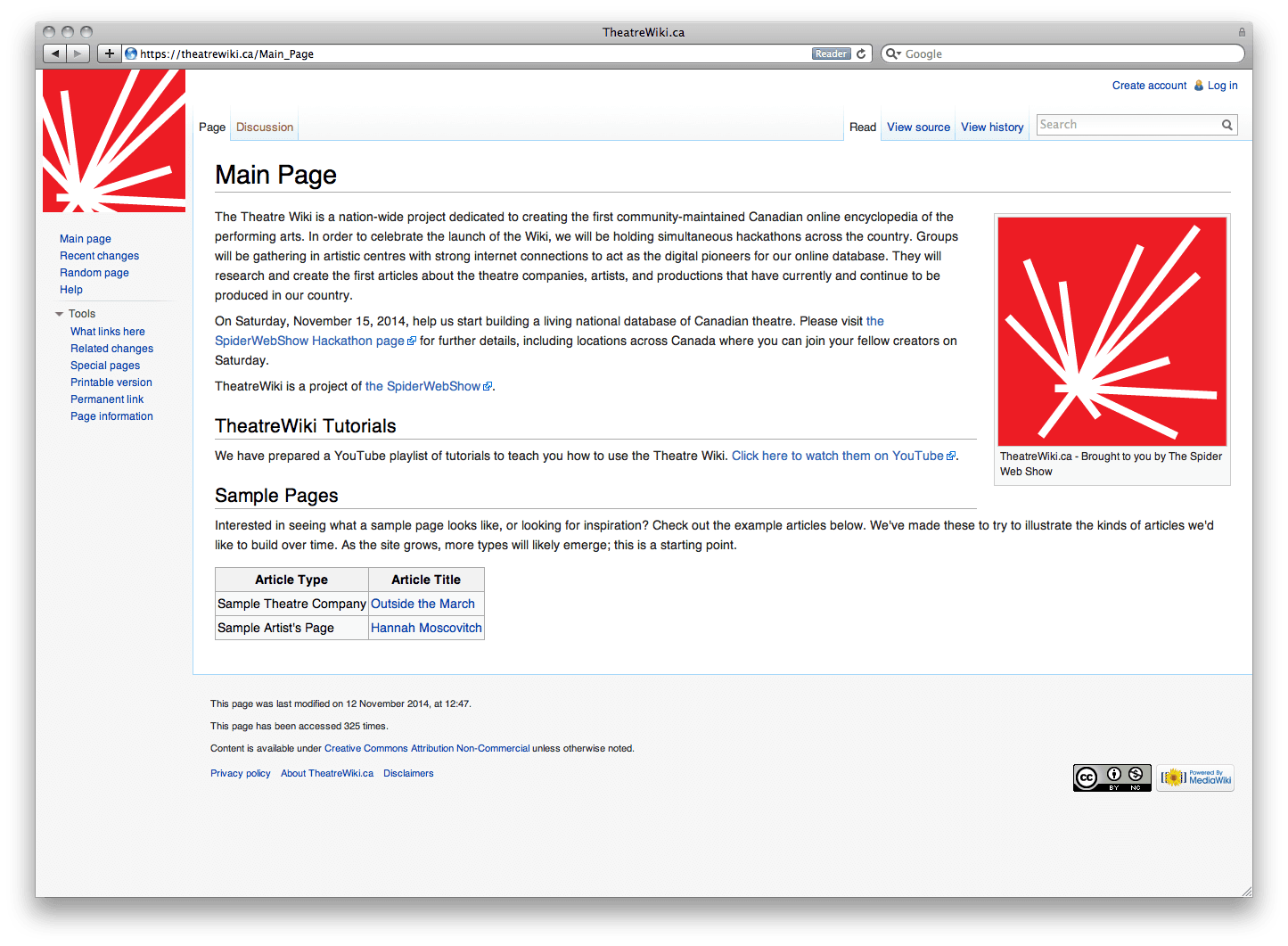
The Theatre Wiki Hackathon will take place on November 15th from 1pm – 4pm EST.
The Theatre Wiki is a nation-wide project dedicated to creating the first community-maintained Canadian online encyclopedia. In order to celebrate the launch of the Wiki, we will be holding simultaneous hackathons across the country. Groups will be gathering in artistic centres with strong internet connections to act as the digital pioneers for our online database. They will research and create the first articles about the theatre companies, artists, and productions that have currently and continue to be produced in our country.
Currently, we have confirmed venues in Victoria (Intrepid Theatre), Vancouver (Meeting Room at PTC), Edmonton (The Citadel), Red Deer (TBD), Calgary (Epcor Center), Regina (Queen City Hub), Saskatoon (TBD), Winnipeg (TBD), Sudbury (TBD), Toronto (Theatre Centre Incubator), Ottawa (Arts Court), Montreal (Mainline), Sackville (Mount Allison), Charlottetown (TBD), Halifax (2b Theatre Board Room), and St John’s (TBD).
Don’t see your city listed here, and interested in participating? Contact us.
Follow the instructions in the step-by-step videos below to learn how to access and update the Theatre Wiki. Or if you’d prefer to watch the videos on YouTube, click here.
If you’d like to skip from lesson to lesson, please click any of the individual links below:
Lesson 0: Welcome to the Theatre Wiki!
Lesson 0.5: Updates to the Theatre Wiki
Lesson 1: Accessing the Theatre Wiki
Lesson 2: Creating an Account on the TheatreWiki
Lesson 3: Creating your first page
Lesson 4: Editing an Article
Lesson 5: Formatting an Article pt1. Bold/Italics/Links
Lesson 6: Formatting an Article pt 2. Headers
Lesson 7: What makes a good article?
Lesson 8: The Discussion Page
Lesson 9: Ordered and Unordered Lists
Lesson 10: Creating References
Lesson 11: Creating a Sample Theatre Company Page
Lesson 12: Creating a Sample Author Page
Lesson 13: Adding Photos to your Articles